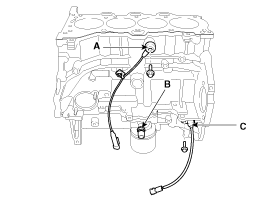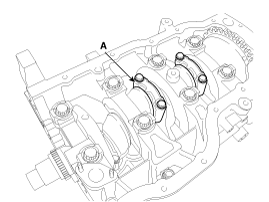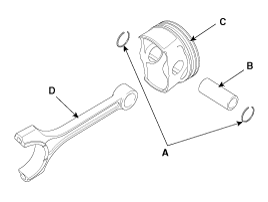 Kia Forte: Piston and Connecting Rod Disassembly
Kia Forte: Piston and Connecting Rod Disassembly
Second generation YD (2014-2018) / Kia Forte TD 2014-2018 Service Manual / Engine Mechanical System / Cylinder Block / Piston and Connecting Rod Disassembly
Engine removal is required for this procedure.
|
|
| 1. |
Remove the engine assembly from the vehicle.
(Refer to Engine And Transaxle Assembly - “Engine And Transaxle
Assembly”)
|
| 2. |
Remove the transaxle assembly from the engine assembly.
Manual Transaxle
(Refer to Manual Transaxle System - "Manual Transaxle")
Automatic Transaxle
(Refer to Automatic Transaxle System - "Automatic Transaxle")
|
| 3. |
Manual Transaxle : Remove the flywheel.
(Refer to Cylinder Block - "Flywheel")
Automatic Transaxle : Remove the drive plate.
(Refer to Cylinder Block - "Drive Plate")
|
| 4. |
Remove the rear oil seal.
(Refer to Cylinder Block - “Rear Oil Seal”)
|
| 5. |
Install the engine to engine stand for disassembly.
|
| 6. |
Remove the timing chain.
(Refer to Timing System - “Timing Chain”)
|
| 7. |
Remove the water pump assembly.
(Refer to Cooling System - “Water Pump”)
|
| 8. |
Remove the water inlet fitting and the thermostat assembly.
(Refer to Cooling System - “Thermostat“)
|
| 9. |
Remove the intake manifold.
(Refer to Intake And Exhaust System - "Intake Manifold")
|
| 10. |
Remove the A/C compressor.
(Refer to Heating, Ventilation Air conditioning -"Compressor")
|
| 11. |
Remove the exhaust manifold.
(Refer to Intake And Exhaust System - "Exhaust Manifold")
|
| 12. |
Remove the cylinder head assembly.
(Refer to Cylinder Head Assembly - "Cylinder Head")
|
| 13. |
Remove the oil filter.
(Refer to Lubrication System - “Engine Oil”)
|
| 14. |
Remove the oil screen.
(Refer to Lubrication System - “Oil Pan”)
|
| 15. |
Remove the knock sensor (A).
|
| 16. |
Remove the oil pressure switch (OPS) (B).
|
| 17. |
Remove the crankshaft position sensor (CKPS) (C).
|
| 18. |
Check the connecting rod side clearance.
|
| 19. |
Check the connecting rod bearing cap oil clearance.
|
| 20. |
Remove the piston and connecting rod assemblies.
|
| 21. |
Check fit between piston and piston pin.
Try to move the piston back and forth on the piston pin.
If any movement is felt, replace the piston and pin as a set.
|
| 22. |
Remove piston rings.
|
| 23. |
Disassemble the connecting rod from the piston.
|
 Piston and Connecting Rod Components
Piston and Connecting Rod Components
1. Piston ring
2. Snap ring
3. Piston pin
4. Piston
5. Connecting rod
6. Connecting rod upper bearing
7. Connecting rod lower bearing
8. Connecting rod bearing cap ...
 Piston and Connecting Rod Inspection
Piston and Connecting Rod Inspection
Connecting Rod
1.
Check the connecting rod side clearance.
Using a feeler gauge, measure the end play while moving the connecting
rod back and forth.
...
See also:
Sunroof Switch Inspection
1.
Disconnect the negative (-) battery terminal.
2.
Remove the overhead console lamp assembly (A) after loosening
2 screws.
...
Components Location
1. Automatic transaxle
2. Inhibitor switch
3. Transaxle Control Module (TCM)
4. Valve body cover
5. Solenoid valve connect
6. Oil temperature sensor
7. Valve body assembly ...
Replacement
Rear Brake Pads
1.
Remove the rear wheel & tire.
Tightening torque:
88.3 ~ 107.9 N.m (9.0 ~ 11.0 kgf.m, 65.1 ~ 79.6 lb-ft ...
Copyright © www.kifomanual.com 2014-2025





